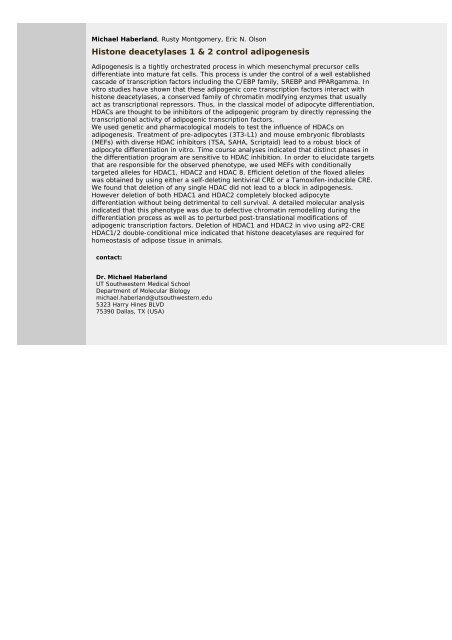Abstracts (poster) - Wissenschaft Online
Abstracts (poster) - Wissenschaft Online
Abstracts (poster) - Wissenschaft Online
You also want an ePaper? Increase the reach of your titles
YUMPU automatically turns print PDFs into web optimized ePapers that Google loves.
Michael Haberland, Rusty Montgomery, Eric N. Olson<br />
Histone deacetylases 1 & 2 control adipogenesis<br />
Adipogenesis is a tightly orchestrated process in which mesenchymal precursor cells<br />
differentiate into mature fat cells. This process is under the control of a well established<br />
cascade of transcription factors including the C/EBP family, SREBP and PPARgamma. In<br />
vitro studies have shown that these adipogenic core transcription factors interact with<br />
histone deacetylases, a conserved family of chromatin modifying enzymes that usually<br />
act as transcriptional repressors. Thus, in the classical model of adipocyte differentiation,<br />
HDACs are thought to be inhibitors of the adipogenic program by directly repressing the<br />
transcriptional activity of adipogenic transcription factors.<br />
We used genetic and pharmacological models to test the influence of HDACs on<br />
adipogenesis. Treatment of pre-adipocytes (3T3-L1) and mouse embryonic fibroblasts<br />
(MEFs) with diverse HDAC inhibitors (TSA, SAHA, Scriptaid) lead to a robust block of<br />
adipocyte differentiation in vitro. Time course analyses indicated that distinct phases in<br />
the differentiation program are sensitive to HDAC inhibition. In order to elucidate targets<br />
that are responsible for the observed phenotype, we used MEFs with conditionally<br />
targeted alleles for HDAC1, HDAC2 and HDAC 8. Efficient deletion of the floxed alleles<br />
was obtained by using either a self-deleting lentiviral CRE or a Tamoxifen-inducible CRE.<br />
We found that deletion of any single HDAC did not lead to a block in adipogenesis.<br />
However deletion of both HDAC1 and HDAC2 completely blocked adipocyte<br />
differentiation without being detrimental to cell survival. A detailed molecular analysis<br />
indicated that this phenotype was due to defective chromatin remodelling during the<br />
differentiation process as well as to perturbed post-translational modifications of<br />
adipogenic transcription factors. Deletion of HDAC1 and HDAC2 in vivo using aP2-CRE<br />
HDAC1/2 double-conditional mice indicated that histone deacetylases are required for<br />
homeostasis of adipose tissue in animals.<br />
contact:<br />
Dr. Michael Haberland<br />
UT Southwestern Medical School<br />
Department of Molecular Biology<br />
michael.haberland@utsouthwestern.edu<br />
5323 Harry Hines BLVD<br />
75390 Dallas, TX (USA)

















